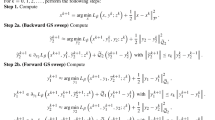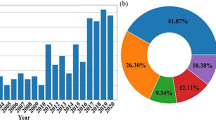Abstract
Finite difference method (FDM) is a well-established variational computational technique to solve problems in image analysis. Compared to the extensively discussed finite difference schemes, very few work has been devoted to finite element method (FEM), which motivates the proposed work. On one hand, FEM has strong physical backgrounds, which allows clear and physically meaningful derivation of difference equations that are easy to implement. On the other hand, combined with the variational methods, the semidiscrete FEM scheme in timescale can give favorable stability and efficiency properties of computations. In this paper, we firstly introduce two classical image denoising models, the Perona–Malik (P–M) model and You–Kaveh (Y–K) model. Then, the finite element numerical algorithm is given for the two models, and the numerical analysis of the algorithm is also presented. These two models correspond to two kinds of nonlinear partial differential equations, the former of which is of fourth order and the latter is of second order. Compared results demonstrate the superiority of the proposed FEM over FDM, in terms of suppressing blocky effects while maintaining the visual quality.










Similar content being viewed by others
References
J.W. Barrett, J.F. Blowey, Finite element approximation of the Cahn–Hilliard equation with concentration dependent mobility. J. Math. Comput. 68, 487–517 (1999)
J.W. Barrett, J.F. Blowey, H. Garcke, Finite element approximation of a fourth order nonlinear degenerate parabolic equation. Numer. Math. 80, 525–556 (1998)
E. Bansch, K. Mikula, A coarsening finite element strategy in image selective smoothing. Comput. Vis. Sci. 1, 53–61 (1997)
F. Catte, P.L. Lions, J.M. Morel, T. Coll, Image selective smoothing and edge detection by nonlinear diffusion. SIAM. J. Numer. Anal. 29(1), 182–193 (1992)
Q.S. Chang, X.C. Tai, L. Xing, A compound algorithm of denoising using second-order and fourth-order partial differential equations. Numer. Math. Theor. Methods Appl. 2(4), 353–376 (2009)
L.C. Evans, Partial Differental Equations (American Mathematical Society, Providence, 1998)
C. Ebmeyer, J. Vogelgesang, Finite element approximation of a forward and backward anisotropic diffusion model in image denoising and form generalization. Numer. Methods Part Differ Equ. 24(5), 646–662 (2008)
J. Kacur, K. Mikula, Solution of nonlinear diffusion appearing in image smoothing and edge detection. Appl. Numer. Math. 17, 47–59 (1995)
Z. Kriva, K. Mikula, An adaptive finite volume scheme for solving nonlinear diffusion equations in image processing. J. Vis. Commun. Image Represent 13, 22–35 (2002)
J.C. Li, Finite element analysis and application for a nonlinear diffusion model in image denoising. Numer. Methods Part Differ. Equ. 18(5), 649–662 (2002)
M. Lysaker, A. Lundervold, X.C. Tai, Noise removal using fourth-order partial differential equation with applications to medical magnetic resonance images in space and time. IEEE Trans. Image Process. 12(12), 1579–1590 (2003)
P. Perona, J. Malik, Scale-space and edge detection using anisotropic diffusion. IEEE Trans. Pattern Anal. Mach. Intell. 12, 629–639 (1990)
L. Rudin, S. Osher, E. Fatemi, Nonlinear total variation based noise removal algorithms. Phys. D 60, 259–268 (1992)
Y.L. You, M. Kaveh, Fourth-order partial differential equations for noise removal. IEEE Trans. Image Process. 9(10), 1723–1730 (2000)
Author information
Authors and Affiliations
Corresponding author
Additional information
Publisher's Note
Springer Nature remains neutral with regard to jurisdictional claims in published maps and institutional affiliations.
This work is supported by National Natural Science Foundation of China (Nos. 11531005, 91330101).
Appendix
Appendix
The finite difference numerical approximation is considered as follows [13]
The discrete grid point is defined as \((ih,jh,n\triangle t)\), and \(u^{k}_{i,j}\) is defined to approximate u(x, y, t) with \(x=ih,~y=jh,~t=n\triangle t~(i,j=1,2,3,\ldots ,N)\), \(g_{i,j}=g(|\nabla u_\sigma |)_{i,j}\). Denote a time step size \(\triangle t\) and a space grid size \(\triangle x =\triangle y =h=1\). Finally, the numerical approximation to (1.2) is given as
P–M equation (1.2) is associated with the following energy functional
\(f(\cdot )\ge 0\) is an increasing function associated with the diffusion coefficient as
The differential equation (1.3) may be solved numerically using finite difference approach. Assuming a time step size of \(\triangle t\) and a space grid size of h, we quantize the time and space coordinates as follows:
where \(N\times N\) is the size of image support. We calculate the Laplacian of the image intensity function as
and
Denote
At the end stage, we calculate the Laplacian of \(c(\cdot )\) as
Finally, the numerical approximation to the differential equation (1.3) is given as
The finite difference numerical scheme of Y–K model is analogous to P–M model.
Moreover, in order to assess the performance of proposed diffusion models, different quantitative measures are calculated using ground truth image (u) and noisy image (f), and the noise is \(n=f-u\). For quantitative evaluation, a widely used measure, signal-to-noise ratio (SNR) can be given as
In addition to SNR, mean-square error (MSE) is defined as
where M and N are numbers of rows and columns, respectively.
We also adopt the structure similarity (SSIM) index to find the similarity between the luminance, contrast and structure of two different images
where \(\mu _x\) and \(\mu _y\) are the mean intensities of X and Y and \(\sigma _x\) and \(\sigma _y\) are the standard deviations of X and Y. The constants are used to avoid instability.
The peak signal-to-noise ratio can be defined as
The peak signal-to-noise ratio can be defined as
Rights and permissions
About this article
Cite this article
Gu, Y. Finite Element Numerical Approximation for Two Image Denoising Models. Circuits Syst Signal Process 39, 2042–2064 (2020). https://doi.org/10.1007/s00034-019-01241-8
Received:
Revised:
Accepted:
Published:
Issue Date:
DOI: https://doi.org/10.1007/s00034-019-01241-8




